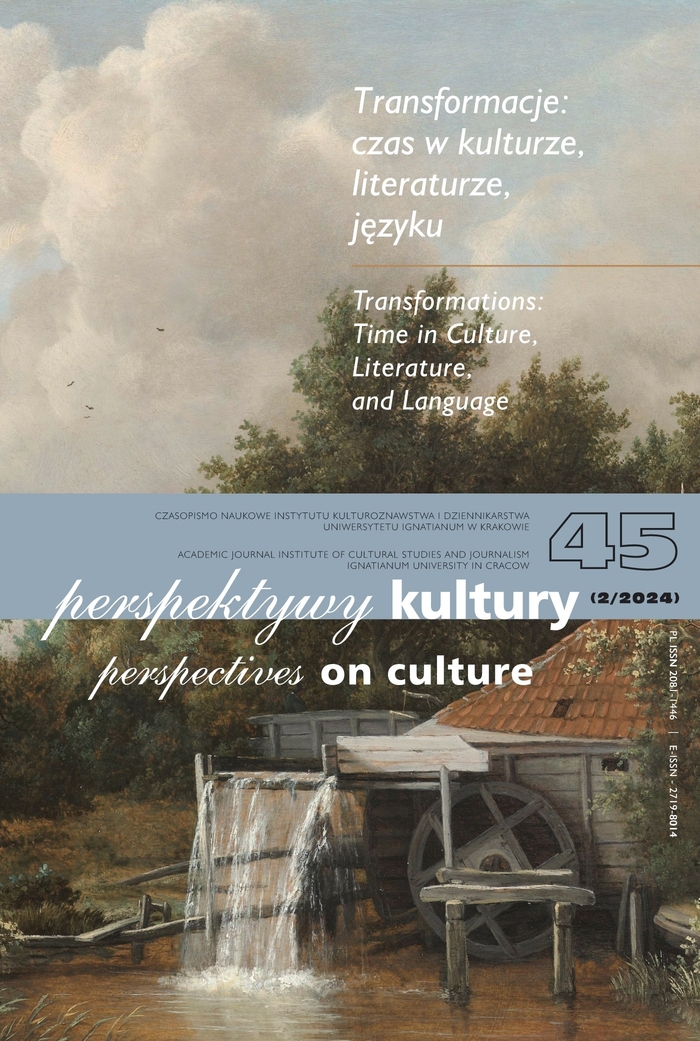„Na morzu ciemnozielonego listowia”
Powrót do Plantatora z Malaty Josepha Conrada w epoce plantacjocenu
Abstrakt
Niniejsza praca wykorzystuje systemową koncepcję „plantacjocenu” w analizie Plantatora z Malaty (PzM) (2012 [1914]) Josepha Conrada, ukazując przy tym autora jako pisarza obecnej epoki geologicznej, w której niszczycielska działalność człowieka doprowadziła do nieodwracalnych zmian na Ziemi. W przyjętym w niniejszym artykule ujęciu czas w PzM nabiera podwójnego, analitycznego znaczenia. Pomimo że praca skupia się na historycznych powiązaniach ekonomicznych inwestycji z imperialnym zamiarem kolonialnego zarządzania naukowego, analizuje ona również PzM z biokolonialnej perspektywy. Perspektywa ta podkreśla rolę przesiedlonego życia roślinnego jako niezwykle istotnego dla ontologicznie pluralistycznej kontekstualizacji PzM jako przykładu plantacjoceńskiej narracji. Z analizy wynika, że PzM zapewnia dostęp do tego, co można nazwać w rozumienia Marka Boulda plantacjonoceńską „nieświadomością”, ponieważ opowiadanie to ukazuje współczesnemu czytelnikowi realia ludzkiej oraz „nie-ludzkiej” (tj. np. roślinnej), dyslokacji, relokacji i ich wyzysku na królewskiej plantacji na początku XX w.
Bibliografia
Armiero, M. & De Angelis, M. (2017). Anthropocene: Victims, Narrators, and Revolutionaries. South Atlantic Quarterly, 116(2), 345–362. DOI: 10.1215/00382876-3829445.
Atkinson, D. (2015). The White Australia Policy, the British Empire, and the World. Department of History Faculty Publications, Paper 4, 1–27. DOI: 10.3366/brw.2015.0191.
Baucom, I. (2014). History 4°: Postcolonial Method and Anthropocene Time. Cambridge Journal of Postcolonial Literary Inquiry, 1(1), 123–142. DOI: 10.1017/pli.2013.13.
Bould, M. (2021). The Anthropocene Unconscious: Climate Catastrophe Culture. London: Verso. [Kindle]
Bradshaw, A.L. (2006). Youthful Latitudes: Joseph Conrad’s Iconography of Geography and Australia. Yearbook of Conrad Studies, (2), 31-44. https://www.jstor.org/stable/26414164.
Bradshaw, A.L. (2007). Joseph Conrad’s “The Planter of Malata”: Timing and the Forgotten Adventures of the Silk Plant «Arghan». Textile, 5(3), 276–299. DOI: 10.2752/175183507X249468.
Bradshaw, A.L. (2008). The Pacific as Rhizome: The Case of Sir Henry Alexander Wickham, Planter, and His Transnational Plants. In D. Deacon, P. Russell and A. Wollacott (Eds.), Transnational Ties: Australian Lives in the World. Canberra: Australian National Press.
Chevalier, A. (1923). Le Pita ou Arghan, plante textile. Revue de botanique appliquée et d'agriculture coloniale, 3 (26), 652–660. DOI: 10.3406/jatba.1923.4109.
Conrad, J. (2010). Youth, Heart of Darkness and “The End of the Tether”, ed. O. Knowles. Cambridge University Press.
Conrad, J. (2012). The Cambridge Edition of the Works of Joseph Conrad: Within the Tides, eds. A. Fachard, L. Davies & A. Purssell. Edinburgh: Cambridge University Press.
Crutzen, P.J. (2006). The «Anthropocene». In: E. Ehlers & T. Kraft (eds.), Earth System Science in the Anthropocene, Heidelberg: Springer, 13–18.
Fachard, A. (2007). The Critical Reception of Within the Tides. Yearbook of Conrad Studies, 3, 115–130. https://www.jstor.org/stable/10.2307/26424129.
Ghosh, A. (2021). The Nutmeg’s Curse: Parables for a Planet in Crisis. Chicago: University of Chicago Press.
Haraway, D. (2015). Anthropocene, Capitalocene, Plantationocene, Chthulucene: Making Kin. Environmental Humanities, 6(1), 159–165. DOI: 10.1215/22011919-3615934.
Haraway, D., Ishikawa, N., Gilbert, S.F., Olwig, K., Tsing, A.L. & Bubandt, N. (2015). Anthropologists Are Talking – About the Anthropocene. Ethnos, 81(3), 535–564. DOI: 10.1080/00141844.2015.1105838.
Hodgson, F.M. (1943). Pacific Islands Pilot: The Central Groups Comprising New Caledonia and Iles Loyalty; the New Hebrides Group and Santa Cruz Islands; the Fiji Islands and the Tonga, Samoa, Ellice, Gilbert, Marshall, Phoenix and Tokelau Islands. 2 vol. London: Hydrographic Department, Admiralty.
Kerr, A. (2009). A Federation in These Seas: An Account of the Acquisition by Australia of Its External Territories, with Selected Documents. Barton: Attorney General Department Press.
McCarthy, J.M. (2009). «A choice of nightmares»: The Ecology of Heart of Darkness. Modern Fiction Studies, 55(3), 620–648. DOI: 10.1353/mfs.0.1624.
Malm, A. (2017). «This is the hell that I have heard of»: Some Dialectical Images in Fossil Fuel Fiction. Forum for Modern Language Studies, 53(2), 121–141. DOI: 10.1093/fmls/cqw090.
MacLeod, R. (1993). Passages in Imperial Science: From Empire to Commonwealth. Journal of World History, 4(1),117–150. https://www.jstor.org/stable/20078549.
MacLeod, R. (1994). Science for Imperial Efficiency and Social Change: Reflections on the British Science Guild, 1905–1936. Public Understanding of Science, 3(2), 155–193. DOI: 10.1088/0963-6625/3/2/003.
Moore, C. (1985). Kanaka: A History of Melanesia Mackay. Port Moresby: Institute of Papua New Guinea Studies and the University of Papua New Guinea Press.
Moore, C. (2000). «Good-bye, Queensland, good-bye, White Australia; Good-bye Christians»: Australia’s South Sea Islander Community and Deportation, 1901–1908. The New Federalist, (4), 22–29.
Moore, C. (2017). Making Mala: Malaita in Solomon Islands, 1870s–1930s. Acton: Australian National University Press.
Moore, C., Leckie, J. & Munro, D. (1990). Labour in the South Pacific. Townsville: James Cook University of Northern Queensland Press.
Moore, J.W. (2016). Introduction. In: J.W. Moore (ed.), Anthropocene or Capitalocene? Nature, History, and the Crisis of Capitalism. Oakland: Kairos, 1–11.
Myers, J. (2001). The Anxiety of Confluence: Evolution, Ecology, and Imperialism in Conrad’s Heart of Darkness. Interdisciplinary Studies in Literature and Environment, 8(2), 97–108. https://www.jstor.org/stable/44085898.
Peters, J.G. (2013). Joseph Conrad’s Critical Reception. New York: Cambridge University Press.
Schneider-Rebozo, Lissa and Jeffrey Mathes McCarthy. 2019. ‘Conrad, Nature and Environmental Criticism’. In Conrad and Nature: Essays, edited by Lissa Schneider-Rebozo, Jeffrey Mathes McCarthy and John G. Peters, 1-17. New York: Routledge.
Science and the Empire. (1907). Nature, (76): 37–38. DOI: 10.1038/076037a0.
Shiva, V. (1997). Biopiracy: The Plunder of Nature and Knowledge. Boston: South End Press.
Taylor, Jesse Oak. 2019. ‘Wilderness after Nature: Conrad, Empire and the Anthropocene’. In Conrad and Nature: Essays, edited by Lissa Schneider-Rebozo, Jeffrey Mathes McCarthy and John G. Peters, 21-42. New York: Routledge.
Copyright (c) 2024 Perspektywy Kultury

Utwór dostępny jest na licencji Creative Commons Uznanie autorstwa – Bez utworów zależnych 4.0 Międzynarodowe.
Autor, zgłaszając swój artykuł, wyraża zgodę na korzystanie przez Wydawnictwo Uniwersystet Ignatianum z utworu na następujących polach eksploatacji:
- utrwalania utworu w formie papierowej, a także na nośniku cyfrowym lub magnetycznym;
- zwielokrotnienia utworu dowolną techniką, bez ograniczenia ilości wydań i liczby egzemplarzy;
- rozpowszechniania utworu i jego zwielokrotnionych egzemplarzy na jakimkolwiek nośniku, w tym wprowadzenia do obrotu, sprzedaży, użyczenia, najmu;
- wprowadzenia utworu do pamięci komputera;
- rozpowszechniania utworu w sieciach informatycznych, w tym w sieci Internet;
- publicznego wykonania, wystawienia, wyświetlenia, odtworzenia oraz nadawania i reemitowania, a także publicznego udostępniania utworu w taki sposób, aby każdy mógł mieć do niego dostęp w miejscu i czasie przez siebie wybranym.
Wydawca zobowiązuje się szanować osobiste prawa autorskie do utworu.





